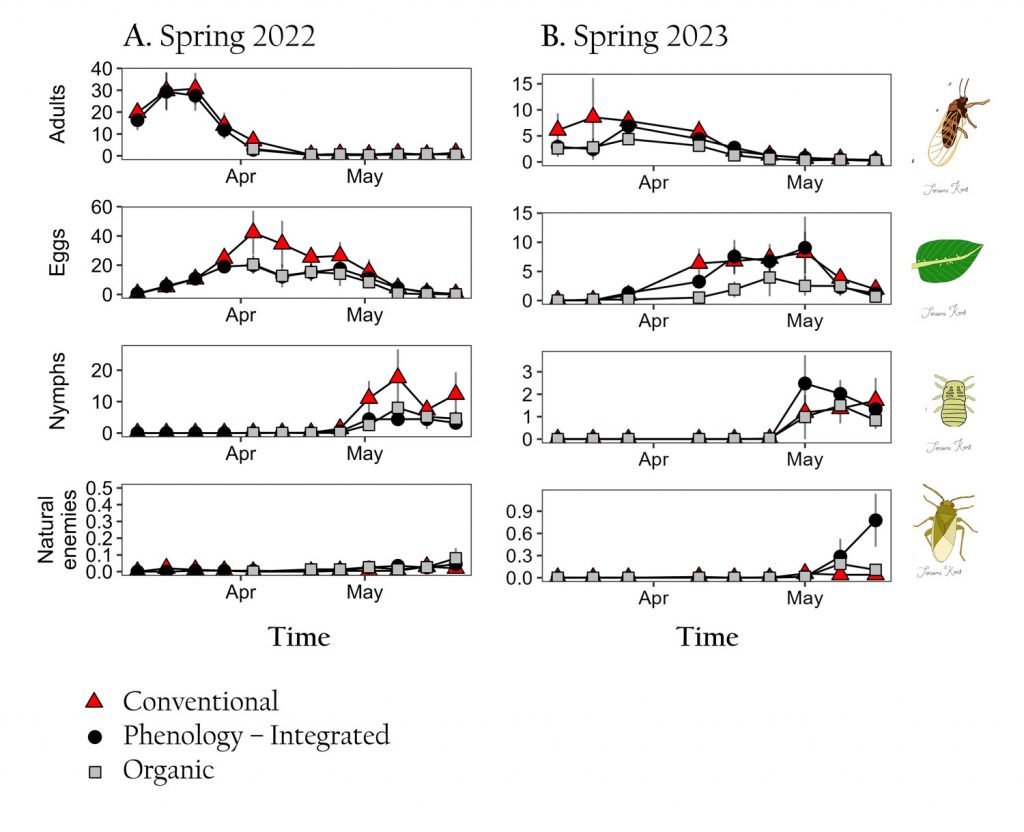Written by Robert Orpet, WSU, 5/27/2023
Spring Leads to Summer
The Pear Insects Lab at WSU has been testing integrated pest management guideline for pear since 2022 with the goal of cheaper and better pear psylla control. Figure 1 shows similar conventional vs. integrated management outcomes in spring 2022 and 2023. This year, first generation pear psylla was about 4 times less abundant than last year, and natural enemy populations in integrated orchards are growing more quickly than last year too. With lower pear psylla and more natural enemies than last year, the integrated program looks to be on track for success going into summer.

Summer, 2023
In June 2023, the second generation of pear psylla is just starting. Summerform adult numbers are increasing, and they are starting to lay eggs. Higher numbers of pear psylla are expected in integrated vs. conventional orchards during this generation. However, if predator and parasitoid populations build, integrated orchards will probably be less sticky than conventional orchards by harvest time.
We have an online two-page summary of the integrated management guidelines that makes use of the pear psylla phenology model (Figure 2). The integrated guidelines involve selective sprays targeted towards the most vulnerable points of the pear psylla lifecycle and cultural tactics like tree washing and summer pruning. Selective codling moth sprays and miticide options are included in the guidelines so pear psylla’s natural enemies remain safe. To follow along with outcomes of this in 2023 and receive free pear psylla degree-day updates like in Figure 2, you can subscribe to Pear Entomology Weekly by e-mailing Robert Orpet.

Looking ahead to Fall 2023
When things go well in an integrated program and biocontrol agents have a vibrant community, pear psylla will practically disappear during their third generation going into harvest. If that doesn’t happen, additional sprays and cultural tactics for the third generation can be timed with the help of the phenology model. I will review third-generation pear psylla outcomes and management guidelines for 2023 in a future issue of Tree Fruit Matters.
Contact
Robert Orpet
WSU
robert.orpet@wsu.edu
Funding and acknowledgements
Thank you Fresh Pear Committee and Processed Pear Committee in addition to WSDA for pear orchard research and Western SARE Project #WRGR23-004 for funds supporting related to earwig workshops.
Additional information
- Learn about pear psylla management
- Get pear psylla degree-days for free
Fruit Matters articles may only be republished with prior author permission © Washington State University. Reprint articles with permission must include: Originally published by Washington State Tree Fruit Extension Fruit Matters at treefruit.wsu.edu and a link to the original article.
Use pesticides with care. Apply them only to plants, animals, or sites listed on the labels. When mixing and applying pesticides, follow all label precautions to protect yourself and others around you. It is a violation of the law to disregard label directions. If pesticides are spilled on skin or clothing, remove clothing and wash skin thoroughly. Store pesticides in their original containers and keep them out of the reach of children, pets, and livestock.
YOU ARE REQUIRED BY LAW TO FOLLOW THE LABEL. It is a legal document. Always read the label before using any pesticide. You, the grower, are responsible for safe pesticide use. Trade (brand) names are provided for your reference only. No discrimination is intended, and other pesticides with the same active ingredient may be suitable. No endorsement is implied.

